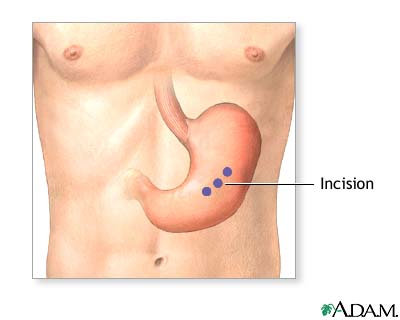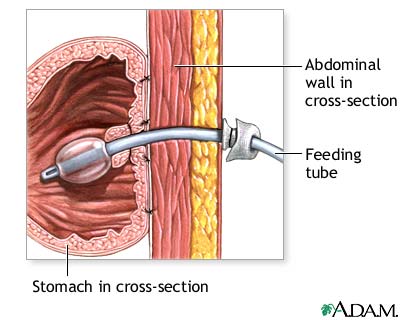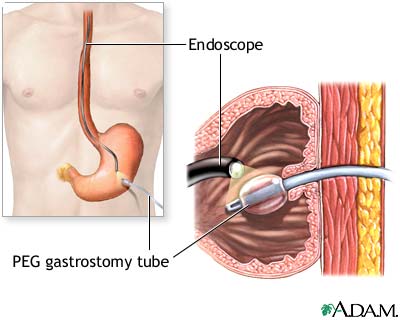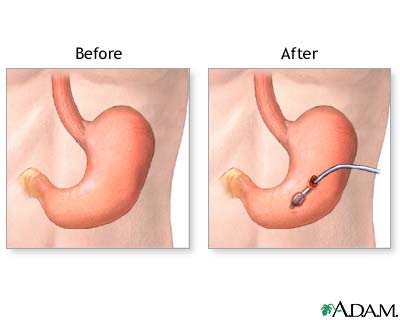Health Library
Gastrostomy tube placement - series

Normal anatomy
The stomach connects the esophagus to the small intestine, and acts as an important reservoir for food, prior to delivery to the small intestine.

Indications
Gastrostomy tubes are inserted for various reasons. They may be needed temporarily or permanently.
Gastrostomy tube insertion may be recommended for:
- Birth defects of the mouth, esophagus, or stomach (esophageal atresia or tracheal esophageal fistula)
- Problems with sucking and/or swallowing, for example in patients debilitated by stroke or dementia

Incision
While the patient is deep asleep and pain-free (general anesthesia), a small incision is made on the left side of the abdomen.

Procedure, part 1
A small, flexible, hollow tube (catheter) with a balloon or flared tip is inserted into the stomach. The stomach is stitched closed around the tube and the incision is closed.

Procedure, part 2
Alternatively, gastrostomy tubes can be placed under endoscopic guidance, using a much smaller incision (percutaneous endoscopic gastrostomy tube placement, or PEG). PEG tube placement can generally be performed under local anesthesia rather than general anesthesia. An endoscope is passed into the mouth, down the esophagus, and into the stomach. The surgeon can then see the stomach wall through which the PEG tube will pass. Under direct visualization with the endoscope, a PEG tube passes through the skin of the abdomen, through a very small incision, and into the stomach. A balloon is then blown up on the end of the tube, holding in place. PEG gastrostomy tubes avoid the need for general anesthesia and a large incision.

Aftercare
The stomach and abdomen generally heals in 5 to 7 days. Moderate pain can be managed with medications. The patient will be fed intravenously (IV) for at least 24 hours. Feedings will begin when bowel sounds are heard. Feedings will start slowly with clear liquids and gradually be increased.
The patient/family will be taught:
- How to care for the skin around the tube
- Signs and symptoms of infection
- What to do if the tube is pulled out
- Signs and symptoms of tube blockage
- How to empty (decompress) the stomach through the tube
- How and what to feed through the gastrostomy tube
- How to conceal the tube under clothing
- What normal activities can be continued
BACK TO TOP
Review Date: 5/29/2024
Reviewed By: Debra G. Wechter, MD, FACS, General Surgery Practice Specializing in Breast Cancer, Virginia Mason Medical Center, Seattle, WA. Also reviewed by David C. Dugdale, MD, Medical Director, Brenda Conaway, Editorial Director, and the A.D.A.M. Editorial team.
 | A.D.A.M., Inc. is accredited by URAC, for Health Content Provider (www.urac.org). URAC's accreditation program is an independent audit to verify that A.D.A.M. follows rigorous standards of quality and accountability. A.D.A.M. is among the first to achieve this important distinction for online health information and services. Learn more about A.D.A.M.'s editorial policy, editorial process and privacy policy. A.D.A.M. is also a founding member of Hi-Ethics. This site complies with the HONcode standard for trustworthy health information: verify here. |
The information provided herein should not be used during any medical emergency or for the diagnosis or treatment of any medical condition. A licensed medical professional should be consulted for diagnosis and treatment of any and all medical conditions. Links to other sites are provided for information only -- they do not constitute endorsements of those other sites. No warranty of any kind, either expressed or implied, is made as to the accuracy, reliability, timeliness, or correctness of any translations made by a third-party service of the information provided herein into any other language. © 1997- 2024 A.D.A.M., a business unit of Ebix, Inc. Any duplication or distribution of the information contained herein is strictly prohibited.
